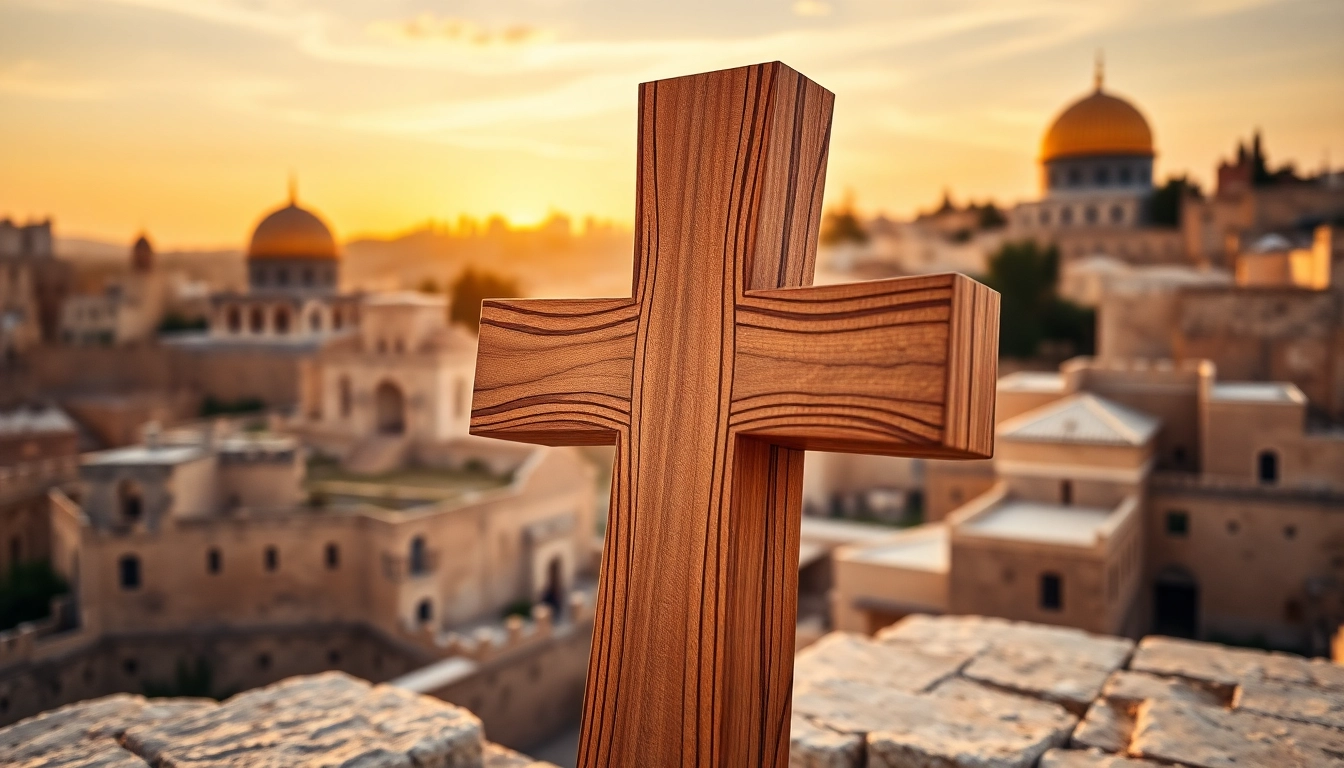Understanding Jerusalem Crosses
What Are Jerusalem Crosses?
The Jerusalem cross, also known as the “five-fold cross” or “cross-and-crosslets,” is a distinct variant of the heraldic cross and a symbol of profound significance within the Christian faith. Its design features a large primary cross potent at the center, surrounded by four smaller Greek crosses—one positioned in each quadrant. This unique arrangement serves as a powerful emblem of Christ’s teachings and the missionary spread of the Gospel, symbolizing the Four Evangelists: Matthew, Mark, Luke, and John. Each cross within the design not only enhances its aesthetic but also carries deep-rooted theological and cultural meanings.
In addition to its spiritual significance, Jerusalem crosses are intricately tied to the historical landscape of Jerusalem, often regarded as the heart of Christianity. Their symbolism spans various interpretations, ranging from the four cardinal directions, suggesting the universality of Christ’s message, to the four continents where Christianity has flourished. Understanding the Jerusalem cross requires delving into its historical, cultural, and artistic dimensions, making it an object of fascination for both believers and historians alike.
The Symbolism Behind the Design
The Jerusalem cross is laden with rich symbolism that extends beyond its visual appeal. The large central cross represents Christ and His sacrifice, while the four smaller crosses signify the four corners of the earth, reinforcing the idea of spreading the Gospel across nations. Each element of the cross harmonizes to communicate themes of unity, faith, and divine love.
Furthermore, this emblem is often linked to the concept of pilgrimage. Early Christian pilgrims journeyed to Jerusalem, and the cross served as a reminder of their faith and commitment. Today, it symbolizes a spiritual journey that echoes the historical pilgrimage paths leading to the Holy City. The Jerusalem cross thus not only acts as a religious symbol but also embodies the journey of faith that each believer undertakes.
The Cultural Impact of Jerusalem Crosses
The Jerusalem cross has transcended its religious origins to become a cultural icon, particularly in artworks, jewelry, and ceremonial artifacts. From intricate mosaics found in ancient churches to contemporary jewelry pieces, the design is versatile and continues to inspire creativity across mediums. Artists frequently draw upon the Jerusalem cross to convey themes of hope and faith in their works.
In various communities, the Jerusalem cross serves as a unifying symbol, promoting interfaith dialogue and understanding. It has been embraced as a symbol of peace by some groups, reflecting the shared heritage and aspirations of different cultures in the region. Thus, the cross acts as both a spiritual emblem and a representation of the collective human experience in the search for meaning and belonging.
Historical Context of Jerusalem Crosses
The Origins in Early Christianity
The origins of the Jerusalem cross can be traced back to early Christianity, emerging in the context of the Byzantine Empire. Its design likely evolved from various crosses used in this period, signifying not only personal faith but also serving as political emblems of the Byzantine rulers. By the 11th century, it began to represent the Kingdom of Jerusalem that was established during the Crusades, becoming a symbol of both religious devotion and military endeavors.
The cross gained notoriety when it became associated with the Latin Kingdom of Jerusalem, founded by the Crusaders. It was widely used on flags, uniforms, and seals, marking the geographical and spiritual claim to the Holy Land. This dual role of the Jerusalem cross—as a religious symbol and a herald of sovereignty—sowed the seeds for its enduring legacy in both Christian and historical discourse.
Jerusalem Crosses During the Crusades
During the Crusades, the Jerusalem cross played a pivotal role as a rallying symbol for the Christian knights. Its presence on banners, shields, and weaponry added a layer of sacred significance to the military campaigns aimed at reclaiming Jerusalem from Muslim rule. The cross served as a reminder of their divine mission, instilling hope and motivation amongst the soldiers amid the trials of war.
Over time, the cross became synonymous with the Crusader identity, transforming its interpretation within the context of conflict and religious fervor. Post-Crusades, it retained its significance, evolving to represent the Christian legacy in the Holy Land and continuing to shape narratives surrounding the historical events connected to the Crusades.
Modern Interpretations and Usage
In contemporary society, the Jerusalem cross has experienced a revival, particularly in religious contexts. Many Christian denominations utilize it as a symbol of faith, hope, and commitment. It often appears in church decor, religious art, and personal jewelry, connecting worshippers with their spiritual heritage.
Additionally, the cross is embraced in ecumenical movements, symbolizing unity and shared values among diverse Christian traditions. Its aesthetic appeal allows it to transcend purely religious circles and enter into cultural dialogues, representing shared human experiences and aspirations. Thus, the modern interpretation of the Jerusalem cross reflects an evolving understanding of faith, identity, and shared histories.
Craftsmanship and Materials
Common Materials Used in Jerusalem Crosses
Jerusalem crosses are often crafted from a variety of materials, reflecting the artisan’s intention and the intended use of the piece. Traditional materials include olive wood, gold, silver, and metal alloys, each chosen for their beauty, spiritual resonance, and durability. Olive wood, in particular, is favored due to its connection to the Holy Land, where olive trees are abundant and have cultural significance in biblical narratives.
Other materials, such as precious gemstones and enamels, are also used to embellish the cross, enhancing its visual appeal and symbolic richness. The choice of materials not only influences the cross’s aesthetic but also contributes to its emotional and spiritual value, making it a treasured item for collectors and believers alike.
Artisans and Their Techniques
The artistry behind Jerusalem crosses reflects a long tradition of craftsmanship. Skilled artisans often employ a variety of traditional techniques, such as hand-carving, casting, and engraving, passed down through generations. Olives wood crosses, for instance, are meticulously carved by hand, showcasing intricate designs that embody the spiritual narratives associated with the cross.
Furthermore, the local cultural context influences the artistic expression, as artisans integrate regional motifs and styles into their work. As a result, each Jerusalem cross can be seen as an artifact of cultural heritage, capturing the unique stories and beliefs of the communities that create them.
Quality Assessment for Authentic Pieces
As with any collectible, discerning the authenticity and quality of Jerusalem crosses is essential for collectors and buyers. Authentic pieces are typically handcrafted by skilled artisans, and there are key factors to consider when assessing their value. Look for detailed craftsmanship, the quality of materials used, and provenance documentation, which can help establish the cross’s authenticity.
Additionally, reputable sellers often provide information on the origin of the cross and the history of the materials used. Engaging in dialogue with the artisan or seller can also lend insight into the cross’s significance. This diligence not only enhances the value of a collection but also deepens the appreciation for the cultural and spiritual narratives they represent.
Jerusalem Crosses in Contemporary Society
Symbolic Significance for Christians Today
For many Christians today, the Jerusalem cross symbolizes more than just a religious icon; it represents a commitment to faith and the journey of spiritual growth. The cross is often utilized during liturgical seasons, particularly in Holy Week and Easter, serving as a visual reminder of Christ’s resurrection and promise of eternal life.
Beyond its liturgical use, the Jerusalem cross can also foster personal reflection and connection with one’s faith community. Many Christians wear the cross as a necklace or display it in their homes, using it as a focal point for prayer and meditation. In this way, the cross acts as a constant reminder of their spiritual values and the teachings of Christ.
Jerusalem Crosses in Jewelry and Gifts
The popularity of Jerusalem crosses extends into the realm of jewelry, where they are crafted into necklaces, bracelets, and earrings, offering believers a means to express their faith stylishly. These jewelry pieces often possess intricate designs and may incorporate precious materials, enhancing their appeal as both spiritual symbols and fashionable items.
Additionally, Jerusalem crosses are popular gifts, especially during religious milestones such as baptisms, confirmations, and weddings. Giving a Jerusalem cross as a gift signifies the giver’s hopes and prayers for the recipient’s spiritual journey, making it a thoughtful and cherished token of faith.
The Role of Jerusalem Crosses in Faith-Based Events
Jerusalem crosses play a prominent role in various faith-based events, including church services, community gatherings, and religious festivals. During these occasions, the cross is often used in processions or as part of decorative displays, symbolizing the foundational beliefs that unite the congregation.
Moreover, some communities incorporate the Jerusalem cross into their social outreach programs, using its image to raise awareness about charitable efforts and cultural heritage. This multifaceted role of the cross ensures its relevance in both personal faith practice and broader community engagement.
Purchasing and Collecting Jerusalem Crosses
Where to Buy Authentic Jerusalem Crosses
When purchasing Jerusalem crosses, it’s essential to seek out reputable vendors known for their commitment to authenticity and quality. Numerous online platforms specialize in handcrafted items from the Holy Land, providing a diverse selection of Jerusalem crosses made from various materials. Moreover, local artisans in Jerusalem often sell their creations in markets and shops, allowing buyers to obtain pieces directly from the source.
In addition to online and local artisan outlets, religious supply stores and specialty gift shops may offer Jerusalem crosses as part of their inventory. Engaging with sellers who prioritize direct trade with artisans further ensures that your purchase supports the local economy while preserving the cultural heritage of the artwork.
Tips for Collecting and Caring for Your Crosses
For collectors, caring for Jerusalem crosses is vital to preserve their beauty and integrity. Begin by ensuring that your crosses are displayed in a safe environment, avoiding exposure to direct sunlight, excessive humidity, or drastic temperature changes, which can damage certain materials.
Regularly cleaning your Jerusalem crosses with a soft, lint-free cloth can help maintain their appearance. Avoid using harsh chemicals or cleaning agents, as these can tarnish the materials. If your cross has intricate carvings or added embellishments, consider consulting an expert for proper maintenance. By following these care guidelines, collectors can ensure that their Jerusalem crosses remain cherished pieces for generations to come.
Understanding the Value of Jerusalem Crosses
The value of Jerusalem crosses is influenced by several factors, including material, craftsmanship, historical significance, and demand within the collector’s market. Authentic pieces made from high-quality materials, particularly those with detailed craftsmanship, tend to command higher prices.
Collectors should research the market to gauge the current value of specific designs and styles. Additionally, understanding the stories and cultural contexts behind each cross adds depth to its value, making it not just an ornament but a testament to the rich heritage of Jerusalem and its enduring spiritual significance.


